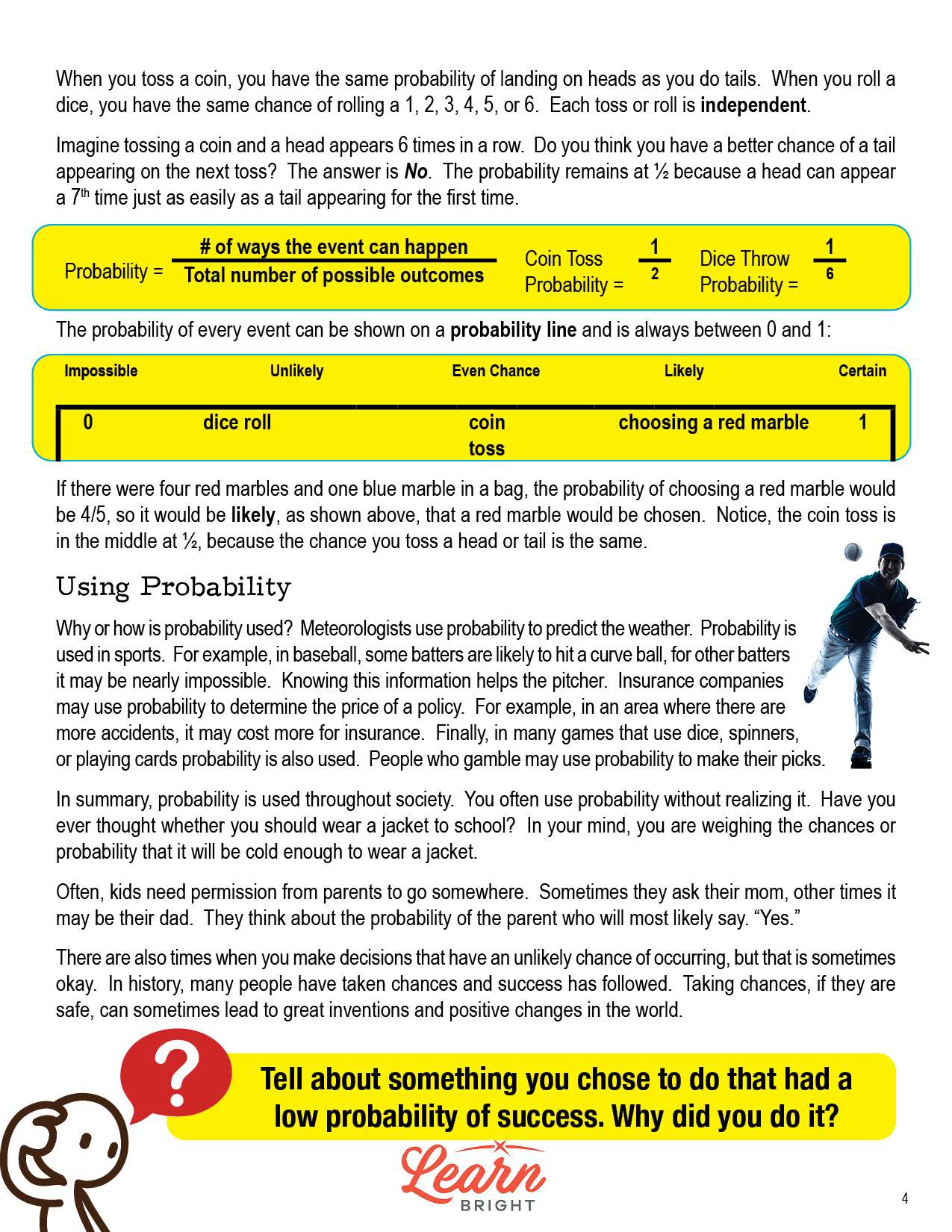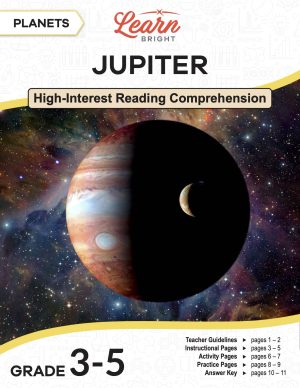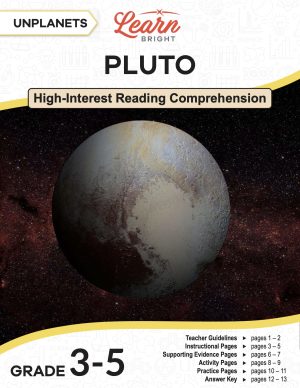Description
What our Probability lesson plan includes
Lesson Objectives and Overview: Probability explores the concepts of probability, including the definition of probability and how to use fractions to determine event probability. At the end of the lesson, students will be able to define probability and determine the probability of events using fractions. This lesson is for students in 4th grade, 5th grade, and 6th grade.
Classroom Procedure
Every lesson plan provides you with a classroom procedure page that outlines a step-by-step guide to follow. You do not have to follow the guide exactly. The guide helps you organize the lesson and details when to hand out worksheets. It also lists information in the blue box that you might find useful. You will find the lesson objectives, state standards, and number of class sessions the lesson should take to complete in this area. In addition, it describes the supplies you will need as well as what and how you need to prepare beforehand. The supplies needed for this lesson include coins, dice, spinners, and the handouts.
Options for Lesson
Included with this lesson is an “Options for Lesson” section that lists a number of suggestions for activities to add to the lesson or substitutions for the ones already in the lesson. All of the suggested adjustments and addition to this lesson relate to the lesson activity. One optional adjustment to the activity is to have your students only do sections A and B. You can also have them use playing cards for an additional exercise. You could record the overall results for the dice roll and spinner for the whole class. If you have older students, you may use include the probability for two dice. Finally, you can use the lesson activity to create graphs and charts as well, such as plotting the coin tosses.
Teacher Notes
The teacher notes page includes a paragraph with additional guidelines and things to think about as you begin to plan your lesson. This page also includes lines that you can use to add your own notes as you’re preparing for this lesson.
PROBABILITY LESSON PLAN CONTENT PAGES
Chances
The Probability lesson plan includes two content pages. Sometimes, you might ask yourself, what are the chances it will rain tomorrow? Or what are the chances you will flip a coin and heads will appear?
We can’t accurately predict most events. However, some events are more likely to happen than others. Some events, like a coin toss, are random, while others are easily predictable. For example, if you study really hard for a test, your chances of earning an “A” are much higher than if you do not study at all. You have more control over your grade than you do over a coin toss.
Weather forecasters try to predict when it will rain using many different tools. They look at weather conditions from the past, current temperature and wind readings, and many other things to help them predict what the weather will be like.
When you say there’s a chance that something will happen, or not happen, that’s probability!
Probability
Any and every event has a chance of happening. Probability is how likely it is that an event will happen. Some events are impossible, like humans flying. Therefore, the probability that a human will fly today is zero percent. However, the probability for a human to fly on a plane is 100%.
Every event, both random and not, has a measurement of probability. We cannot perfectly predict most things. For example, even if you study for a test, there is still a probability that that you might earn a “B” instead of an “A.” When a weather forecaster says that there is a 100% chance of rain, there is still a small chance that it might not. Some events are more likely than others.
It’s not hard to find the probability of an event, especially for things like tossing a coin, rolling dice, or choosing a specific card from a deck. Some events have predetermined outcomes. We can give them probabilities using fractions or percentages.
Examples
Let’s look at an example—tossing a coin. Coins have heads and tails. When we toss a coin in the air, the result is either heads or tails. There are two possible outcomes. Because there are two outcomes, the probability of the result being heads is 1 out of 2 and the possibility of the result being tails is 1 out of 2. Both probabilities are 1/2. Therefore, if you toss a coin in the air, 1/2 of the time it may be heads and 1/2 of the time it may be tails. There’s a 50% chance of either outcome.
Let’s look at another example—throwing dice. A single dice has six possible outcomes: 1, 2, 3, 4, 5, 6. Because there are six outcomes, the probability of any single result is 1 out of 6, or 1/6. Therefore, 1 out of 6 times that you roll a dice, you may roll any number 1/6 of the time (about 16%).
Tossing a coin has the same probability of landing on heads or tails. Rolling a dice has the same chance of rolling a 1, 2, 3, 4, 5, or 6. Each toss or roll is independent.
If you tossed a coin and heads appeared six times in a row, do you have a better chance of a tail appearing the next time you toss it? The answer is no! The probably is still the same, 1/2, because heads can appear just as easily on the seventh toss as it did on the first time.
Probability Formula
We can use a formula to determine probability. Probability = # of ways the event can happen / total number of possible outcomes.
To find the probability of a coin toss, we can use the formula: Coin toss probability = 1/2. To find the probability of a dice throw, we can use the formula: Dice throw probability = 1/6.
We can show the probability of any event on a probability line. Probability is always between 0 and 1, where 0 is impossible and 1 is certain. The probability of a specific outcome of a dice roll is 1/6, so it’s closer to impossible than certain. The probability of a specific outcome of a coin toss is 1/2, so it’s directly in the middle of impossible and certain (an even chance).
If you had four red marbles and one blue marble in a bag, your probability of choosing a red marble would be 4/5. On our scale from 0 to 1, this means that drawing a red marble is likely.
Using Probability
So how and why do we use probability? As discussed, meteorologists use probability to predict the weather. In baseball, some batters are likely to hit a curve ball, while it’s nearly impossible for others. Knowing this information helps the pitcher. Insurance companies use probability to determine the prices of their policies. For example, in an area where there are more accidents, insurance may cost more. Finally, probability is used in many games that use dice, spinners, or playing cards. People who gamble often use probability to make their picks.
Probability is all around you! You likely often use it without realizing. If you’ve ever thought that you should wear a jacket to school, you’re actually thinking about the probability that it will be cold enough to need a jacket.
If a kid needs permission to go somewhere or do something, they might choose to ask one parent instead of the other. They do this because they think there’s a higher probability that one parent will say yes than the other.
Sometimes, you might make decisions that have an unlikely chance of occurring. That’s okay! In history, many people have taken chances and had success. Taking chances, if they are safe, can sometimes lead to great inventions and positive changes in the world.
PROBABILITY LESSON PLAN WORKSHEETS
The Probability lesson plan includes three worksheets: an activity worksheet, a practice worksheet, and a homework assignment. You can refer to the guide on the classroom procedure page to determine when to hand out each worksheet.
TOSSING, ROLLING, AND SPINNING ACTIVITY WORKSHEET
Students will work with a partner to complete the lesson activity. Each pair will complete three exercises titled Tossing the Coin, Rolling the Dice, and Spin the Spinner. For each exercise, they will first answer some questions about probability. They will then use the dice, coin, and spinner to complete each chart, taking turns tossing, rolling, and spinning. Each pair will track and count their results. Finally, they will answer the questions following each exercise and will share their results with the class.
MULTIPLE-CHOICE PRACTICE WORKSHEET
The practice worksheet asks students to read ten multiple-choice problems and select the correct answer for each.
PROBABILITY HOMEWORK ASSIGNMENT
For the homework assignment, students will cut out the numbers (1 through 10) printed on the worksheet and place them in a bowl or hat. Next, they will answer a few questions about the probability of drawing different numbers from the bowl or hat. After they answer the questions, they will have ten family members or friends randomly pick one of the numbers from the hat or bowl, returning the number after each pick. They will record the results in the chart. Finally, they will answer the rest of the questions on the worksheet.
Worksheet Answer Keys
This lesson plan includes answer keys for the activity worksheet, the practice worksheet, and the homework assignment. If you choose to administer the lesson pages to your students via PDF, you will need to save a new file that omits these pages. Otherwise, you can simply print out the applicable pages and keep these as reference for yourself when grading assignments.









